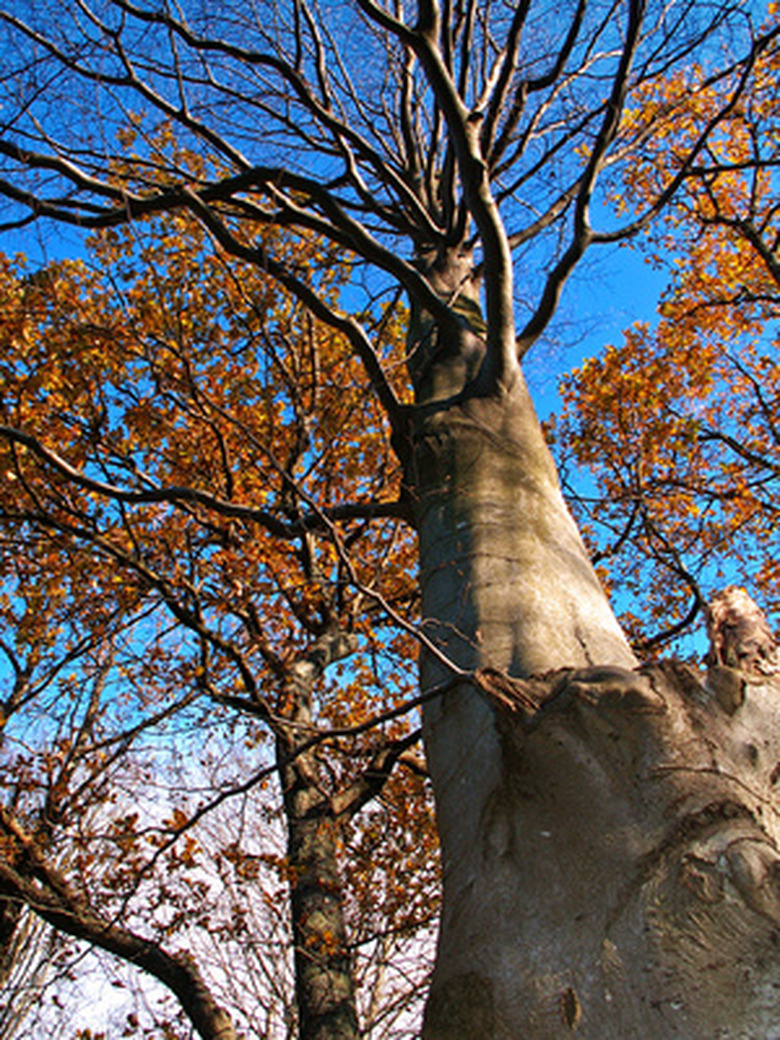Variegated Leaf Beech Tree
Normally growing 50 to 70 feet tall and 50 feet wide, the European beech's (Fagus sylvatica) golden bronze fall foliage and muscular gray bark make it one of the most beautiful deciduous shade trees. European beech also comes in purple-leaf forms, and one variegated selection in particular dazzles with pink, purple and cream foliage: 'Purpurea Tricolor'. It grows to about 30 feet tall with a spread of 20 feet in USDA hardiness zones 5 through 8.
Origins
The European beech's natural growing range extends from central Europe eastward to the Carpathian Caucasus Mountains. The variegated beech tree was selected in Germany around 1880, according to the Learn2Grow plant database, and Coenosium Gardens' Bob Finkham states that this selection first received the variety name of 'Roseomarginata' in 1888. Although modern nurseries simply label it incorrectly merely as 'Tricolor', the current accepted variety name remains 'Purpurea Tricolor'.
Ornamental Features
This spreading-branched tree bears bronze-green leaves shaped like ovals with wavy edges. These edges also show irregular stripes of pink and pale pinkish-cream. When first emerging in spring, the leaves display a much more purple hue before slightly fading to bronze-green by midsummer. From a distance, the tree looks like it's a flowering tree, perhaps a flowering dogwood, with the overall cast of light pink. Up close the foliage reveals the mottled and streaked variegation on nearly every leaf. In autumn the leaves turn bronze-gold before dropping away.
- Normally growing 50 to 70 feet tall and 50 feet wide, the European beech's (Fagus sylvatica) golden bronze fall foliage and muscular gray bark make it one of the most beautiful deciduous shade trees.
Cultural Requirements
All European beech trees prosper in fertile and deep soils that contain lots of organic matter. The soil must not be alkaline. A moist soil with good drainage also ensures best growth. Variegated and purple-leaf selections of copper beech need partial shade conditions, where no more than 4 to 6 hours of direct sunlight reaches the multicolored foliage. The more pink and white in the foliage, the less sunlight it needs before scalding or browning of leaf edges. Choose a location sheltered under taller shade tree branches, especially where shaded in the heat of the summer afternoon. In regions with long hot summers 'Tricolor Purpurea' falters, needing more watering to maintain a consistently moist soil. Mulch over the root zone retains moisture and shades the soil to reduce temperatures.
- All European beech trees prosper in fertile and deep soils that contain lots of organic matter.
- Variegated and purple-leaf selections of copper beech need partial shade conditions, where no more than 4 to 6 hours of direct sunlight reaches the multicolored foliage.
Uses
The beauty and relative rarity of the variegated leaf beech tree finds it used as a singular specimen in a landscape. In regions with short, cool summers it may tolerate a bit more sunlight and become a large, rounded tree for a lawn or edge of a woodland. Warmer climates lead to its use as a woodland tree growing with dappled shade under taller extant trees. European beeches tolerate sheering nicely to create formal hedges, but such an ornately leafed plant like 'Purpurea Tricolor' would not look its best highly manicured.
Other Types
While 'Purpurea Tricolor' may be one of the most ornamental and desirable of the variegated leaf beeches for a landscape, other varieties exist. Selection 'Luteovariegata' bears yellow to gold-edged green leaves that tend to fade to yellow-green by midsummer. Both ” and 'Silverwood' produce leaves with stripes or fleeting mottled blotches of white or cream on their green leaves.
- The beauty and relative rarity of the variegated leaf beech tree finds it used as a singular specimen in a landscape.
- While 'Purpurea Tricolor' may be one of the most ornamental and desirable of the variegated leaf beeches for a landscape, other varieties exist.
